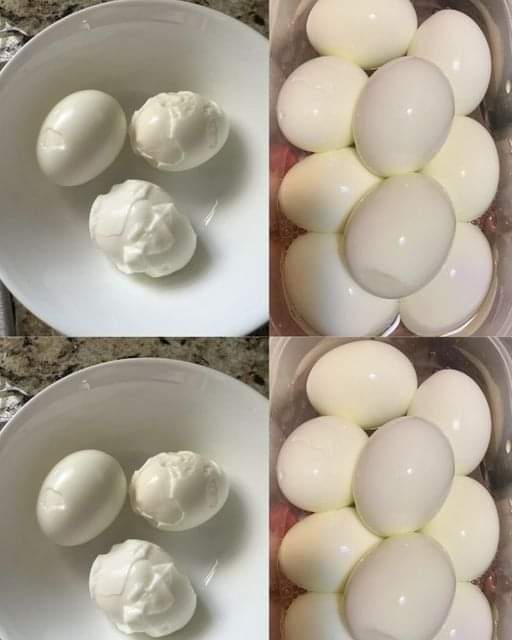The key to easily peeling hard-boiled eggs lies in shocking the eggs in ice water right after boiling. This technique helps separate the egg white from the shell, making it easy to remove the shell without damaging the egg.
Step-by-Step Guide
What You’ll Need:
Eggs (fresh eggs are great, but slightly older eggs peel even easier)
Water
Ice
A large pot
A bowl for the ice bath
Step 1: Boil the Eggs
Place the eggs in a pot: Arrange your eggs in a single layer in a large pot. Add enough cold water to cover the eggs by about an inch. Starting with cold water helps ensure the eggs cook evenly.
Bring to a boil: Place the pot on the stove and bring the water to a boil over medium-high heat. Once the water is boiling, reduce the heat slightly to maintain a gentle boil.
Cook the eggs: Let the eggs boil for 10-12 minutes, depending on how well-cooked you like your yolk. For fully hard-boiled eggs, aim for 12 minutes.
Step 2: Prepare the Ice Bath
While the eggs are boiling, prepare an ice bath. Fill a large bowl with ice and cold water. The ice bath is essential because it stops the cooking process immediately and helps loosen the egg shells.
Step 3: Transfer Eggs to the Ice Bath
Shock the eggs: Once the eggs are done boiling, use a slotted spoon or tongs to carefully transfer them from the pot into the ice bath. Let the eggs sit in the ice water for at least 5-10 minutes. This cooling process makes the shell contract, pulling it away from the egg white and making peeling much easier.
Tap the eggs: After the eggs have cooled, take one egg at a time and gently tap it on a hard surface (like a countertop) to crack the shell. Roll the egg under your palm to loosen the shell all around.
Step 4: Peel the Eggs
Peel under running water: Peel the cracked shell off the egg, starting at the wider end (this is usually where there’s a small air pocket, making it easier to get under the shell). Peeling under a gentle stream of cold water can help wash away any tiny shell fragments and make the peeling process smoother.
Why This Method Works
The rapid temperature change from boiling water to the ice bath creates a thermal shock, which causes the egg white to slightly pull away from the shell. This makes the shell much easier to remove in larger pieces instead of tiny frustrating bits. Plus, the cold water stops the cooking process, preventing overcooked eggs with a greenish ring around the yolk.
Bonus Tips for Peeling Hard-Boiled Eggs
Use older eggs: Eggs that are a few days old tend to peel more easily than fresh eggs because the egg white shrinks slightly inside the shell as they age.
Add baking soda or vinegar to the boiling water: Some people swear by adding a teaspoon of baking soda or a splash of vinegar to the water before boiling. These additives can change the pH of the egg white, making it easier to separate from the shell.
Tap and roll: Once the egg has cooled, gently tap the egg on a hard surface and roll it under your palm to create cracks all around the shell. This makes peeling more effortless and faster.
Final Thoughts
With this clever trick, peeling hard-boiled eggs will never be a struggle again. The ice bath method is simple, quick, and effective, giving you perfectly peeled eggs every time. Whether you’re prepping for a party or just want a quick, healthy snack, this technique will make your egg prep much easier—and your eggs much prettier!
Now that you know this clever trick, it’s time to put it to the test. Try it with your next batch of hard-boiled eggs, and you’ll never go back to struggling with stuck-on shells again!
